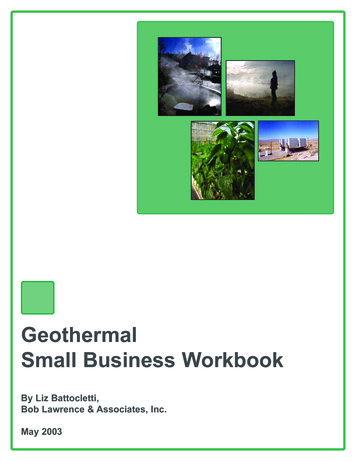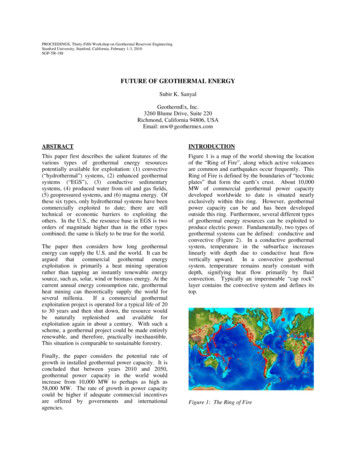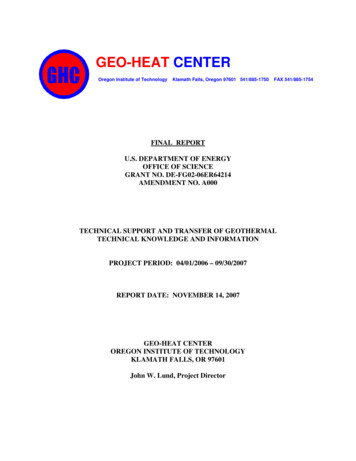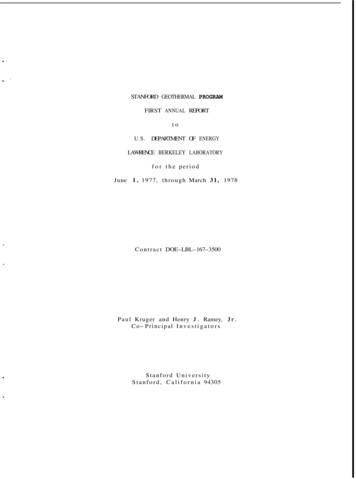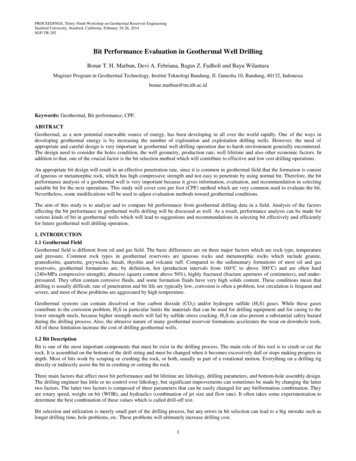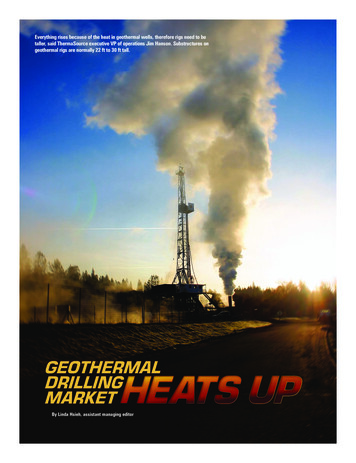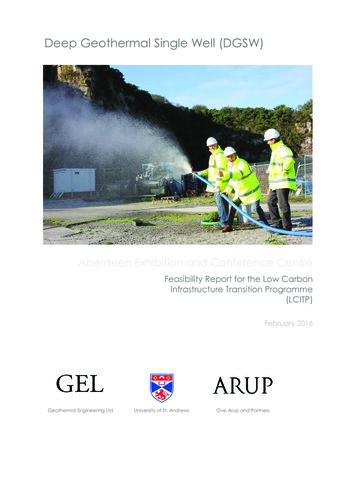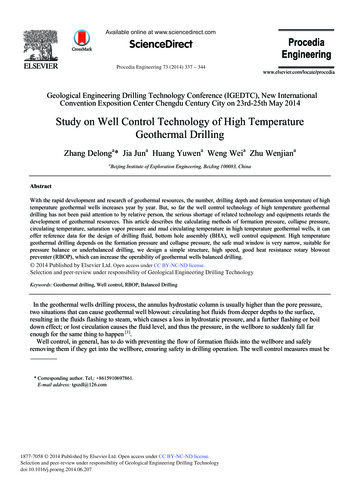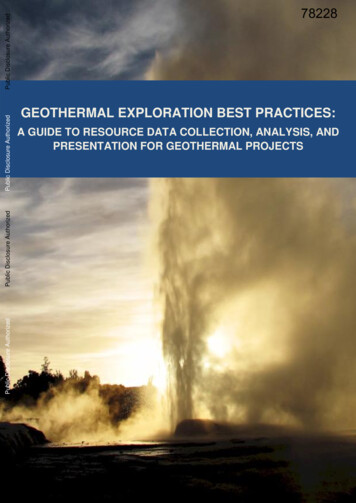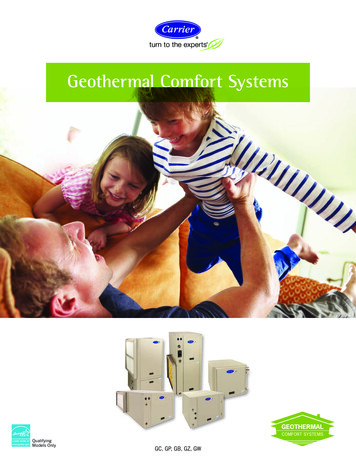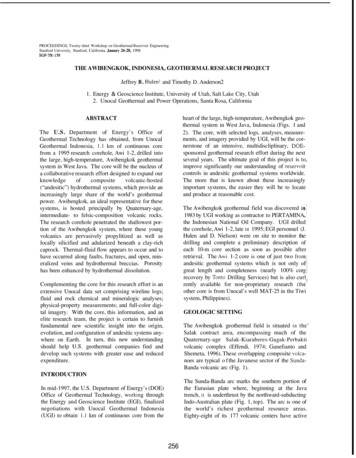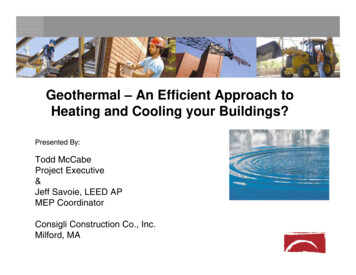
Transcription
Geothermal – An Efficient Approach toHeating and Cooling your Buildings?PresentedPresented By:By:Todd McCabeProject Executive&Jeff Savoie, LEED APMEP CoordinatorConsigli Construction Co., Inc.Milford, MA
Seminar Agenda Project experienceHow geothermal worksConstruction timelineComparison of system typesConstructability issues – what to be aware ofLessons learned
Completed Geothermal Projects City Hall Annex, Cambridge, MA Harvard QRAC, Cambridge, MA Abromson Community Education Ctr., USM, Portland, ME Harvard Blackstone Building, Cambridge, MA Education Building, U Maine, Farmington, ME Project Place Gatehouse, Boston, MA Walker Art Building, Bowdoin College, Brunswick, ME Alternatives Unlimited Mill Renovation, Whitinsville, MA
Geothermal Projects in Progress Community Rowing Boathouse, Cambridge, MA Ames Free Library, Easton, MA
Geothermal - How It WorksHeating Cycle Fluid circulates through the loop extracting heat Heat energy is transferred to geothermal heat pump Extracted heat is compressed to a high temperature Delivered to building through normal duct or radiant system
Geothermal - How It WorksCooling Cycle Reverse process used for cooling System removes heat from building space and deposits it intothe ground Fluid is cooled by ground temperatures and returned to heatpump for continuous cooling
Types of Mediums Three mediums used to extract heat from or reject heat:- Horizontal Loop- Vertical Loop- Standing Column Well (SCW)
Horizontal Loop Closed systems Circulate water/glycol solution The ground temperature heats orcools
Vertical Loop Closed system Series of bore holes– 8-inches in diameter– 450-feet deep Number depends on heating /cooling loads Spaced 20-feet apart Produce 2 tons capacity per bore Typically used in locations withlimited real estate
Standing Column Well Open loop system Water pumped into building andreturned to well Typical Well: 6- to 8-inches in diameter 1500-feet deep Advantages: Small footprint on site Improved efficiency
Comparison To Conventional Systems Cost – Well(s) vs. boiler / chiller. Life cycle cost analysis (LCCA) Energy Efficiency – Geothermal systems are up to 40% moreefficient than ASHRAE 90 Rebates and Incentives – Tax credits, local and federal rebates Architectural Flexibility – Size of mechanical spaces
Comparison To Conventional Systems Aesthetics – Rooftop units, pad mounted chiller or condensingunits Maintenance / Operation – Spin down filters, glycol feeders(where applicable) Environmental Impact – Geothermal systems use nocombustibles
Environmental and Energy Benefits Most energy efficient, clean and cost effective for space conditioning(EPA) No emissions generated More than 750,000 installations– Eliminate 4.4 million metric tons of CO2 annually– 6 billion kWh electrical use annually– 30 trillion BTUs of fossil fuel annually
Geothermal Feasibility Location– Conditions affect efficiency Hydrology– Availability of ground source water Life Cycle Cost– Preliminary design for specific heating / cooling loads– Comparison to conventional systems– Payback / ROI
Construction Side of Geothermal
Geothermal Construction Timeline Procurement (30 to 45 days) Options for procurement Sub to the Mechanical Subcontractor Sub to the CM/GC Separate drilling and well piping subs to the CM/GC Permitting (30 to 60 days) NPDES Local Board of Health Special Permits (MWRA)
Geothermal Construction Timeline Submittals and Shop Drawings (30 days) Review by Project Architect Review by Mechanical Consultant Review by Geothermal Consultant Review by Commissioning Agent (on LEED projects) Drilling Wells (about 1 week per well) Mobilization to site (2 to 3 large rigs and trucks) Set-up of water filtration devices (frac tanks, pumps, etc) Purging and testing of water quality
Geothermal Construction Timeline Well Pump and line installation (30 days) Field installation of UG piping to mechanical room Coordination with mechanical subcontractor Coordination with site utilities and operations Testing and Startup (10 days) Commissioning of systems during MEP Startup Training
Constructability Issues – 10 items to be Ready For Procurement Permitting Site Constraints Water Handling Drilling Operations and Safety
Constructability Issues – 10 items to be Ready For Unforeseen Geological Conditions Groundwater Limitations Vibration and Noise Impact Coordination between Well side and HVAC side Owner Training / Maintenance / Operations
Procurement 1 stop shopping Hold different contracts forindividual trades involved
Permitting Obtain early in the process Get help from consultantsand well drillers Know your requirements
Site Constraints Impact of Drill and SupportRigs on other operations Spacing and Location ofWell Heads (60’ apart)
Water Handling Water CollectionOperations Water Discharge Drainage/Sewersystems Waterways On-site recharge
Drilling Operations &Safety Impact of drilling operationson other construction Mechanical failures Worker safety on the jobsite
UnforeseenGeological Conditions Collapsing Well Holes Contaminated overburdenSoils
GroundwaterLimitations Shared Water Source Low Flow from Wells Poor Water Quality
Vibration & NoiseControl Occupant and/or NeighborExpectations Scheduling of Well Drillingoperations
Coordination Between Engineers andDesign Consultants Between Well Installers andHVAC Subcontractors
Owner Training /Maintenance / Operations New system for mostowners & facility personnel Thorough training needed –involvement duringcommissioning of systems Videotaping of trainingcrucial
The Types of Geothermal Systems Water to Water– Larger capacity– Centrally located in dedicated mechanical space Water to Air– 1 to 5 ton capacity– Located in space they serve
Water to Water vs. Water to Air SystemsComparison of 80 ton geothermal system supplying heatingand cooling in a 20,000 sq. ft. building: Water to Water– 4, 20-ton heat pumps, centrally located– 4 pipe systems with insulation and balancing– Approximately 15 fan coils Water to Air– Centrally located heat exchanger– 16, 5-ton heat pumps located throughout the building
Consigli Case Studies
Case Study: Cambridge City Hall Annex (3) 1500’ standing column well design,open loop systemSystem Use: Heating & CoolingCost of Geothermal Well Drilling Work:N/ABuilding Type: Office spaceBuilding Size: 33,216 sq. ft.Architect: HKT Architects Inc.MEP Engineer: Arup
Lesson Learned: Cambridge City Hall Annex Issue: Postage stamp sized construction boundaries in downtown Cambridge. Solution: Extensive site logistics plans were developed which involved owner, sitecontractor, well driller and local authorities in order to locate and coordinate drilling rig,frac tanks and well discharge water with other trades. Issue: The City of Cambridge is governed under the Massachusetts Water ResourcesAuthority (MWRA) which has its own permitting process outside the general DEPrequirements. This project being our first geothermal system, we were unfamiliar with thetimeframe of MWRA permitting which took several months to obtain. Solution: During preconstruction investigate all permitting requirements on a project /town / city specific basis.
Case Study: Harvard Blackstone (2) 1500’ standing column well design (2) 30 ton heat pumps, chilled wateronly dispersed via valance units System Use: Cooling only Cost of Geothermal Well DrillingWork: 178,000 Building Type: Academic OfficeSpace Building Size: 48,000 sq. ft. Architect: Bruner/Cott & Associates,Inc. Engineer: Arup
Lesson Learned: Harvard Blackstone Issue: The variable frequency drives (VFD’s) associatedwith the (2) well pumps were furnished by the well drillingsubcontractor. Nearing the later part of the project, the ATCcontractor found that their direct digital control (DDC) logicwas not compatible with these particular VFD controlboards. The new VFD’s took (2) weeks to ship and installimpacting the project schedule.Solution: If the well pumps are to be monitored via the DDCsystem, have the HVAC contractor furnish the VFD’s.
Case Study: Abromson Community Center (2) 1500’ standing column welldesign(2) 30 ton heat pumps.System Use: Heating & CoolingCost of Geothermal Well DrillingWork: N/ABuilding Type: AcademicClassroomBuilding Size: 35,000 sq. ft.Architect/Engineer: EinhornYaffee Prescott
Lesson Learned: Abromson Community Center Issue: The two wells and heat pumps were designed to runindependent of each other without a common headermanifold. This design proved to be less energy efficientthan if a common supply and return header was utilized. Solution: Perhaps an outside engineering firm should bebrought in to peer review the documents prior DD.
Case Study: Gatehouse @ Project Place (2) 1500’ standing column welldesign, via heat exchangers(2) 30 ton heat pumpsSystem Use: Heating & CoolingCost of Geothermal Well DrillingWork: N/ABuilding Type: Office BuildingBuilding Size: 25,000 sq. ft.Architect: Hacin & Associates, Inc.MEP Engineer: RW Sullivan
Lesson Learned: Gatehouse @ Project Place Issue: Due to high levels of brackish well water, the well pump motors, checkvalves and heat exchangers material specification changed from 304 stainlessto titanium per the engineers direction. The well water was not tested as earlyas they could have been and due to the lead-time associated with thesetitanium products the well system schedule was slightly delayed. Solution: Test the well water quality as well as GPM and temperature rating assoon as possible so that the proper size and material for pumps, VFD’s andassociated equipment may be ordered. Also, it is a good idea to order areplacement well pump with that initial order incase a pump fails and is readilyat hand.
Case Study: Walker Art Museum, Bowdoin College (4) 1500’ standing column welldesign.System Use: Heating & CoolingCost of Geothermal Well DrillingWork: 245,000Building Type: Art MuseumBuilding Size: 48,000 sq. ft.Architect: Machado and SilvettiAssociates, Inc.MEP Engineer: Altieri SeborWieber Consulting Engineers
Lesson Learned: Walker Art Museum, Bowdoin College Issue: Upon testing the GPM at each well, the flow rateswere so deficient that an alternate system had to beestablished from what was originally designed. Solution: During preconstruction conduct extensivegeotechnical exploration in areas that haven’t beenpreviously used in geothermal applications.
Summary: The Construction Side of Geothermal1. Plan, Plan, Plan2. Procure the right subs for the situation3. Tight coordination between Architect, Consultant and CMand even tighter between CM, mechanical sub andgeothermal subcontractor4. Owner involvement throughout the start up andcommissioning phasesWater Energy Distributors Inc
Questions / Contact InformationTodd McCabeConsigli Construction Co., Inc.72 Sumner StreetMilford, MA 01757(508) 458-0336tmccabe@consigli.comJeff SavoieConsigli Construction Co., Inc.72 Sumner StreetMilford, MA 01757(508) 458-0343jsavoie@consigli.com
Cost of Geothermal Well Drilling Work: 245,000 Building Type: Art Museum Building Size: 48,000 sq. ft. Architect: Machado and Silvetti Associates, Inc. MEP Engineer: Altieri Sebor Wieber Consulting Engineers. Lesson Learned: Walker Art Museum, Bowdoin College
